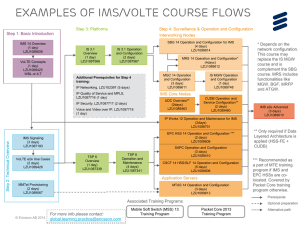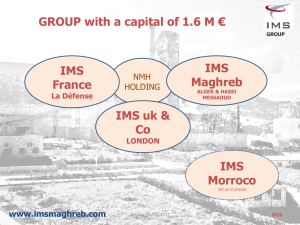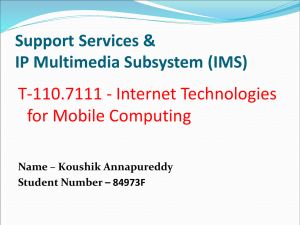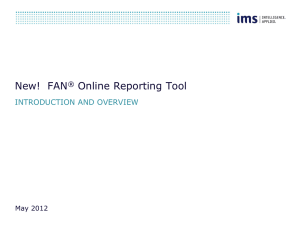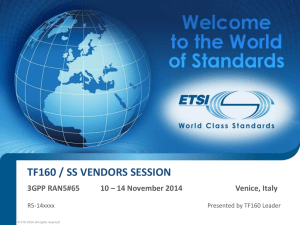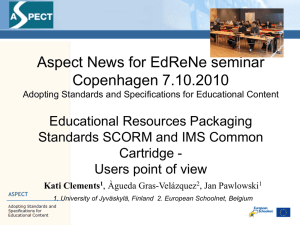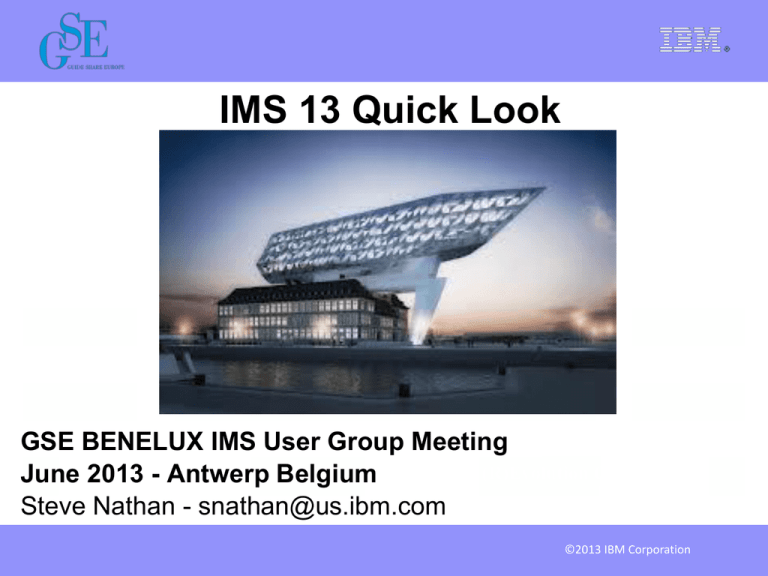
IMS 13 Quick Look
GSE BENELUX IMS User Group Meeting
The (R)Evolution Continues
June 2013 - Antwerp Belgium
Steve Nathan - snathan@us.ibm.com
©2013 IBM Corporation
GSE BENELUX IMS User Group Meeting – June 2013
Disclaimer
© Copyright IBM Corporation 2013. All rights reserved.
U.S. Government Users Restricted Rights - Use, duplication or disclosure restricted by GSA ADP Schedule
Contract with IBM Corp.
THE INFORMATION CONTAINED IN THIS PRESENTATION IS PROVIDED FOR INFORMATIONAL
PURPOSES ONLY. WHILE EFFORTS WERE MADE TO VERIFY THE COMPLETENESS AND
ACCURACY OF THE INFORMATION CONTAINED IN THIS PRESENTATION, IT IS PROVIDED “AS
IS” WITHOUT WARRANTY OF ANY KIND, EXPRESS OR IMPLIED. IN ADDITION, THIS
INFORMATION IS BASED ON IBM’S CURRENT PRODUCT PLANS AND STRATEGY, WHICH ARE
SUBJECT TO CHANGE BY IBM WITHOUT NOTICE. IBM SHALL NOT BE RESPONSIBLE FOR ANY
DAMAGES ARISING OUT OF THE USE OF, OR OTHERWISE RELATED TO, THIS PRESENTATION
OR ANY OTHER DOCUMENTATION. NOTHING CONTAINED IN THIS PRESENTATION IS
INTENDED TO, NOR SHALL HAVE THE EFFECT OF, CREATING ANY WARRANTIES OR
REPRESENTATIONS FROM IBM (OR ITS SUPPLIERS OR LICENSORS), OR ALTERING THE TERMS
AND CONDITIONS OF ANY AGREEMENT OR LICENSE GOVERNING THE USE OF IBM PRODUCTS
AND/OR SOFTWARE.
IBM, the IBM logo, ibm.com, and IMS are trademarks or registered trademarks of International Business
Machines Corporation in the United States, other countries, or both. If these and other IBM trademarked terms
are marked on their first occurrence in this information with a trademark symbol (® or ™), these symbols
indicate U.S. registered or common law trademarks owned by IBM at the time this information was published.
Such trademarks may also be registered or common law trademarks in other countries. A current list of IBM
trademarks is available on the Web at “Copyright and trademark information” at
www.ibm.com/legal/copytrade.shtml
IMS 13 Quick Look
2
GSE BENELUX IMS User Group Meeting – June 2013
Acknowledgement
This presentation was originally prepared by Diane Goff
– IBM Advanced Technical Solutions (ATS)
Additional material is from Alison Coughtrie
– European IMS Architecture Team
IMS 13 Quick Look
3
GSE BENELUX IMS User Group Meeting – June 2013
Agenda
Status of IMS Versions
Prerequisites, Migration, Coexistence
System Enhancements
Transaction Manager and Connectivity Enhancements
Database and DBRC Enhancements
IMS 13 Quick Look
4
GSE BENELUX IMS User Group Meeting – June 2013
Introducing IMS13 – Smarter Than Ever!
IMS 13 Quality Partnership Program Announced on
October 3, 2012
– Program began on December 14, 2012
– QPP participants have installed and are testing IMS 13
– General availability of IMS 13 will be announced at a later date.
Announcement Letter available on ibm.com
Current Status
– 12 customers in IMS 13 QPP in 2013
– All customers through Sandbox production
– 5 customers have IMS 13 in AD environments
– 3+ targeted for full production by GA
IMS 13 Quick Look
5
GSE BENELUX IMS User Group Meeting – June 2013
Status of IMS Versions
IMS Version 9
– End of service was November 7, 2010
IMS Version 10
– Generally available on October 26, 2007
– End of service was November 5, 2012
IMS Version 11
– Generally available on October 30, 2009
– Will be withdrawn from Marketing on September 9, 2013
– End of service has not been announced
IMS Version 12
– Generally available on October 28, 2011
– End of service has not been announced
IMS Version 13
– Announced on October 3, 2012
– Currently in QPP program
– General availability has not been announced
IMS 13 Quick Look
6
GSE BENELUX IMS User Group Meeting – June 2013
Software Prerequisites
Minimum software level prerequisites
– z/OS V1R13 (5694-A01)
• RACF (included in separately orderable SecureWay Security Server), or
equivalent, if security is used
• High Level Assembler Toolkit Release 5 (5696-234)
• APAR OA39392 / PTF UA66823 is required for z/OS 1.13 for IMS V13
– IRLM 2.3 if the IRLM is used
* subject to change
IMS 13 Quick Look
7
GSE BENELUX IMS User Group Meeting – June 2013
Software Prerequisites ...
Minimum software levels for optional functions
– Java Dependent Regions requires JDK 6.0.1
– ISC TCP/IP requires CICS 5.1
– Depending on the environment, the IMS Universal Drivers require:
• IBM JDK 6.0.1 or later
• DB2 V9.1 or later
• WAS V7 or later
• CICS V4.1 or later
– DB Versioning requires implementation of the IMS Catalog
* subject to change
IMS 13 Quick Look
8
GSE BENELUX IMS User Group Meeting – June 2013
Software Prerequisites ...
Minimum software levels for optional functions ...
– IMS 13 supports interactions with
• DB2: Versions 9, 10
• CICS: Versions 3.2, 4.1, 4.2, 5.1
– CICS 5.1 (newly announced) is required for ISC TCP/IP support
• Requires z/OS 1.13
• MQ for z/OS: Versions V7.0.1, V7.1
– Note V6 EOS was September 2012
– 7.01 introduced MQ message expiry interfacing with IMS transaction
expiration
– 7.1 enhanced the expiry support and support for OTMA resource
monitoring protocol messages
* subject to change
IMS 13 Quick Look
9
GSE BENELUX IMS User Group Meeting – June 2013
Hardware Prerequisites
IMS 13 runs only on 64 bit processors running in
z/Architecture mode
– Processors must also support the Long-Displacement Facility of the
z/Architecture
– ESA mode is not supported
– For a list of z/Series machines see:
www.ibm.com/systems/z/hardware/
z900 machines must be at GA2 level (microcode level 3G or later)
IMS 13 Quick Look
10
GSE BENELUX IMS User Group Meeting – June 2013
Hardware Prerequisites ...
Sysplex Data Sharing (including Data Caching and VSO
Data Sharing)
– Coupling Facility (CF) level 9, or later
Shared Queues and Shared EMH support
– Coupling Facility level 9 or later
– System-managed CF Duplexing
• CF level 12, or later and bidirectional CF to CF links
EAV support for non-VSAM data sets
– EAVs are supported on DS8000 at microcode level R4.0 via bundle
64.0.175.0 (Sept 2008) or higher
IMS 13 Quick Look
11
GSE BENELUX IMS User Group Meeting – June 2013
Supported Migrations and Coexistence
IMS 12 to IMS 13
– Upgrade RECONs from IMS 12 to IMS 13
– Databases are compatible
– Application programs are compatible
IMS 11 to IMS 13
– Upgrade RECONs from IMS 11 to IMS 13
– Databases are compatible
– Application programs are compatible
Check Release Planning documentation at GA for
additional prerequisites/coexistence/migration items
IMS 13 Quick Look
12
GSE BENELUX IMS User Group Meeting – June 2013
IMS 13 System Enhancements
IMS Connect Enhancements
Concurrent Application Threads
Reduced Total Cost of Ownership (TCO)
IMS Command Enhancements
IMS CQS Enhancement
IMS DRD Enhancement
IMS User Exit Enhancements
IMS Security Enhancements
/DIAG Command Enhancements
IMS 13 Quick Look
13
GSE BENELUX IMS User Group Meeting – June 2013
IMS Connect Enhancements
XML Converter Enhancements
Auto-restart of the Language Environment (LE)
Expanded Recorder Trace Records
Use of RACF Event Notification Facility (ENF)
Support for cached RACF UserIDs (UID)
Reporting of overall health to Workload Manager
(WLM)
Configurable TCP/IP backlog (queue) size
IMS 13 Quick Look
14
GSE BENELUX IMS User Group Meeting – June 2013
XML Converter Enhancements
Support for extending the current limit of 100 up to
2000 for the maximum number of XML converters
• New IMS Connect configuration parameter MAXCVRT
ADAPTER(…, MAXCVRT= value)
• IMS 12 (PM64487 / UK79728)
Capability to view converters that are currently loaded
– New Type-2 Command: QUERY IMSCON TYPE(CONVERTER)
• Requests detailed information about XML converters in IMS Connect
Benefits
– Enhances the flexibility of converter usage
• Directly impacts IMS Soap Gateway environments
IMS 13 Quick Look
15
GSE BENELUX IMS User Group Meeting – June 2013
Auto-restart of the Language Environment (LE)
Automated mechanism to reinitialize the Language
Environment when an XML converter ABENDs
– Without restarting IMS Connect
– Converters will be reloaded as they are needed
Automatic refresh of the BPE User Exit for the XML
Adapters (HWSXMLA0) after the ABEND limit ABLIM
has been reached
Benefit
– Improved efficiencies during error conditions
• Eliminates IMS Connect restart and user interactions
IMS 13 Quick Look
16
GSE BENELUX IMS User Group Meeting – June 2013
Expanded Recorder Trace Records
The Recorder trace records have been expanded to:
– Capture entire messages sent and received using:
•
All TCP/IP communications
– Including DRDA sockets and ISC TCP/IP
•
SCI (OM, ODBM, MSC, and ISC communications)
•
Requires a Trace Level HIGH and use of the external trace data set
UPDATE TRACETABLE NAME(RCTR) OWNER(HWS) LEVEL(HIGH) EXTERNAL(YES | NO)
Benefits
– Improved diagnostics and problem determination
IMS 13 Quick Look
17
GSE BENELUX IMS User Group Meeting – June 2013
RACF Event Notification Facility (ENF) Support
Background
– IMS Connect V12 provided the option to cache RACF UserIDs (UIDs)
along with a command to refresh them
IMS Connect V13: RACF ENF Support for Cached
UserIDs (UID)
– Automatically refreshes cached UIDs by listening to RACF events
(ENF signals) indicating that a change has been made to a UID
– NOTE: This function applies only when RACF UID caching has been
enabled in IMS Connect
Benefit
– Allows IMS Connect to listen for certain RACF events indicating that
a change has been made to a specific UserID
• Avoids manual intervention
IMS 13 Quick Look
18
GSE BENELUX IMS User Group Meeting – June 2013
Reporting of Overall Health to WLM
WLM (Workload Manager) Health Report
– New function to automatically report the overall health of IMS
Connect
• Allows Sysplex Distributor to use and take into account this
information for workload balancing
Benefit
– Allows WLM to know when resources are constrained or available
– Minimizes the possibility of Sysplex Distributor assigning work
that IMS Connect is unable to handle
IMS 13 Quick Look
19
GSE BENELUX IMS User Group Meeting – June 2013
Configurable TCP/IP backlog (Queue) size
New parameter TCPIPQ
– Allows users to configure the length of the queue in TCP/IP for
connection requests that have not yet been assigned a socket.
• Connection requests are held on this queue until IMS Connect can
assign a socket
– Overrides the default which is equal to the maxsoc value
• Actual value used is the smaller of IMS Connect’s TCPIPQ value and
SOMAXCONN in TCP/IP
Benefit
– Provides a configurable option to increase the backlog queue size in
TCP/IP
IMS 13 Quick Look
20
GSE BENELUX IMS User Group Meeting – June 2013
Overall Value of IMS Connect Enhancements
Enhanced usability while providing better
performance and diagnostics
Increased resiliency to Abnormal Ends (ABENDs)
Improved usability and manageability
IMS 13 Quick Look
21
GSE BENELUX IMS User Group Meeting – June 2013
Concurrent Application Threads Enhancement
Partition Specification Table (PST) used for
– Active dependent regions (MSG/BMP/IFP/JMP/JBP)
– CICS/DBCTL threads
– Open Database Access threads
Customers continue to require more PSTs!
–
–
–
–
15 dependent regions - 197? (IMS 360)
31 dependent regions - 1980 (IMS 1.1.6)
999 dependent regions - 1995 (IMS 5.1)
4095 dependent regions - 2013 (IMS 13)
Related parameters
–
–
–
–
MAXPST=
PST=
MAXTHRDS= for ODBM
MAXTHRDS=, MINTHRDS= for DBCTL
IMS 13 Quick Look
22
GSE BENELUX IMS User Group Meeting – June 2013
MAXPST= parameter
Used in DBC, DCC, and IMS procedures
– Specifies the maximum number of PSTs for an online IMS
control region
– Default is 255 (no change)
– Maximum value is 4095 in IMS 13 (quadrupled)
Controls maximum number of
– Active dependent regions (MSG/BMP/IFP/JMP/JBP)
– CICS/DBCTL threads
– Open Database Access threads
Reducing MAXPST= requires a cold start
IMS 13 Quick Look
23
GSE BENELUX IMS User Group Meeting – June 2013
Benefits of the Concurrent Thread Enhancement
Customers can now have increased
capacity/scalability for their IMS systems
– Larger capacity for mergers/acquisitions
• Without having to add more IMS images
– Increased workloads with latest zEnterprise hardware
• Room for vertical growth
– More regions for IMS 13 synchronous program switch function, also
synchronous callout, distributed syncpoint/etc.
• Longer region occupancies
MAXPST should no longer be a limiting factor in IMS
growth
IMS 13 Quick Look
24
GSE BENELUX IMS User Group Meeting – June 2013
Reduced Total Cost of Ownership
Cross-platform focus on reducing mainframe software
costs
Major focus on reducing CPU usage
Changes throughout IMS to improve performance,
reduce storage usage and reduce CPU used to run IMS
–
–
–
–
–
–
–
Using more efficient storage services
Improved algorithms
Reducing pathlength
Optimizing frequently used processes
Latch / lock improvements
Storage reductions
Use of zEnterprise hardware functions
IMS 13 Quick Look
25
GSE BENELUX IMS User Group Meeting – June 2013
Specific Reduced TCO Enhancements
IMS logger LOG latch contention reduction
– Improves usage of log latch and log buffer management for increased logging
bandwidth and more efficient processing
Shared queues local first optimization now applies to program-to-program
switch messages as well as ordinary input messages
– Avoids false scheduling on another IMS when the local IMS can process the
program-to-program switch message
Exploitation of pageable 1M pages
– Based on usage of new zEC12 processors with Flash Express storage and z/OS
1.13 (Dec. 2012)
– Provides improvements in dynamic address translation and usage of translation
lookaside buffer (TLB)
DB Space Management Block Serialization Latch Improvements
– Split from single to multiple latches to improve heavy BMP workloads
MEMDSENQMGMT Exploitation
– More efficient memory-based data set ENQ management improves allocation of large
number of data sets
IMS 13 Quick Look
26
GSE BENELUX IMS User Group Meeting – June 2013
Other Reduced TCO Enhancements
OTMA YTIB chain changed from a single linked list to a hash table, to
improve FINDDEST performance.
Convert OTMA and IMS Connect STORAGE calls to CPOOL
Remove unnecessary clearing of OTMA buffers
DFSCPY00 improved SVC directory entry search algorithm and removal of
IVSK instructions.
OSAM CML Lock Reduction
General instruction optimization (replacing STCK with STCKF, long
displacement facility exploitation)
IMS cache manager spin loop elimination
CQS mainline modules changed to use branch-relative branching
Cache efficiency improvements (DPST blocks packed into a single IPAGE
to keep cache references localized)
IMS page load service algorithm optimization
IMS dispatcher optimizations
IMS 13 Quick Look
27
GSE BENELUX IMS User Group Meeting – June 2013
ESAF support in Java Dependent Regions (JDR)
With IMS 13, there are two methods for accessing DB2
from JDRs
– Access via the previously existing DB2 RRSAF interface
– Access via the standard ESAF interface
With IMS 13, the ESAF interface can be used in
JMP/JBP regions to access any ESAF defined to the
IMS control region
– WebSphere MQ, DB2, WOLA (WebSphere Optimized Local
Adapter)
Support for the SSM= parameter on the JMP/JBP
dependent region startup JCL
Only one ESS connection method allowed per JMP/JBP
– Default ESS connection method is DB2 RRSAF
• No impact to existing users
IMS 13 Quick Look
28
GSE BENELUX IMS User Group Meeting – June 2013
IMS Command Enhancements Overview
DBRC command enhancements
DEDB Alter command enhancements
/DIAGNOSE SNAP command enhancement
HALDB command enhancements
IMS Connect type-2 command enhancements
– Dynamically create data store definitions (CREATE IMSCON
TYPE(DATASTORE))
– Dynamically create port definitions (CREATE IMSCON
TYPE(PORT))
– Query XML converters loaded in IMS Connect (QUERY
IMSCON TYPE(CONVERTER)
IMS 13 Quick Look
29
GSE BENELUX IMS User Group Meeting – June 2013
IMS Command Enhancements
Enhancements are focused on type-2 commands for
the Operations Manager (OM) environment
Benefits
– Support of new IMS 13 functions
– Improved manageability
IMS 13 Quick Look
30
GSE BENELUX IMS User Group Meeting – June 2013
IMS CQS Enhancement
When IMS Common Queue Server (CQS) rejects a
z/OS STOP cqsjobname command because CQS
clients are still connected (CQS0300I), CQS issues a
new message, CQS0301I, for each connected client
– Enables the operator to shut down or quiesce the connected
CQS clients so that the CQS address space can be stopped
Benefits
– Improved manageability for CQS
IMS 13 Quick Look
31
GSE BENELUX IMS User Group Meeting – June 2013
IMS DRD Enhancement
Support for the IMS repository (a single centralized
store for resource definitions in an IMSplex)
enhanced to validate resource attributes between
associated resources when a resource definition is
added to, updated in, or deleted from the IMSRSC
Repository
– Validates transaction, routing code, and program attributes
Also provided through the IMS 12 service process
– APAR PM32805 / PTF UX75915
Benefits
– Simplifies management of the DRD resources
IMS 13 Quick Look
32
GSE BENELUX IMS User Group Meeting – June 2013
IMS 13 User Exit Enhancements
Enhanced user exit services extended to additional
IMS control region user exits
Users can now dynamically refresh more IMS user
exit routines to bring in an updated version of the exit
(or add/delete)
– Significantly reduces downtime since IMS control region no
longer requires restart
Users can now display information about more user
exits that are defined in the USER_EXITS section of
DFSDFxxx
– Provides useful exit information to the user
Users can now code an exit to leverage IMS’s ability
to call multiple routines of the same type from a
single point within the exit
IMS 13 Quick Look
33
GSE BENELUX IMS User Group Meeting – June 2013
Enhanced User Exit Services Added to More
Control Region Exit Types
BSEX (DFSBSEX0, Build Security Environment Exit)
NDMX (DFSNDMX0, Non-Discardable Message Exit)
RASE (DFSRAS00, Resource Access Security Exit)
OTMAYPRX (DFSYPRX0, OTMA Destination Resolution
Exit)
OTMARTUX (DFSYRTUX, OTMA Resume TPIPE Security
Exit)
OTMAIOED (DFSYIOE0, OTMA Input/Output Edit Exit)
LOGWRT (DFSFLGX0, Logger Exit)
LOGEDIT (DFSFLGE0, Log Edit Exit)
IMS 13 Quick Look
34
GSE BENELUX IMS User Group Meeting – June 2013
IMS Security Enhancements
All IMS security settings can now be defined as IMS
startup parameters
– Updates to SECURITY macro in system definition (SYSGEN) no
longer required due to its removal
– Previously, certain settings could only be defined in SECURITY
macro
Move security user exits out of the IMS nucleus into
31-bit storage
– DFSCSGN0
– DFSCTRN0
– DFSCTSE0
IMS 13 Quick Look
35
GSE BENELUX IMS User Group Meeting – June 2013
New IMS Startup Security Parameters
RCLASS parameter added to DFSPBxxx in PROCLIB
– RCLASS support in DFSDCxxx PROCLIB member will remain
• DFSPBxxx RCLASS parameter value will override DFSDCxxx if specified
in both
SECCNT parameter added to DFSDCxxx in PROCLIB
Retrofit SPE APARs/PTFs available for IMS startup
security parameter enhancement activation in IMS 11 and
IMS 12
– PM48203/UK74050 (IMS 11)
– PM48204/UK74051 (IMS 12)
– If specifying RCLASS in DFSPBxxx/DFSDCxxx, can also have the
following APARs/PTFs applied to avoid an error message being
issued when it shouldn’t be
• PM72199/UK82616 (IMS 11)
• PM73558/UK82617 (IMS 12)
IMS 13 Quick Look
36
GSE BENELUX IMS User Group Meeting – June 2013
/DIAGNOSE Command Enhancements
Process for capturing diagnostic data used in
troubleshooting IMS issues has been simplified
– SYSOUT option now available for /DIAGNOSE SNAP output
• Documentation can be gathered/stored in a readable format that is
easy to retrieve and send to IBM support
• Time-consuming SYSLOG searches and manual data formatting prior
to transmission no longer required
– /DIAGNOSE SNAP command extended to include more resources
+ more coverage of existing resources
• SHOW() support added for LTERM, NODE and USER
• BLOCK – can now specify multiple single instance blocks and more
blocks can be snapped
• More blocks can be snapped for DB, LINE, LINK
• MSNAME support added
IMS 13 Quick Look
37
GSE BENELUX IMS User Group Meeting – June 2013
/DIAGNOSE Command Enhancements
Benefits
– Cost effective, non-disruptive alternative to console dumps
– /DIAGNOSE command is now more interactive
• Can be used more as a tool for easing the real-time diagnosis process
– Decreased time and effort required in capturing diagnostic
information
– Improved turn-around time in problem resolution
IMS 13 Quick Look
38
GSE BENELUX IMS User Group Meeting – June 2013
Summary of IMS 13 System Topics
IMS Connect Enhancements
Concurrent Application Threads
Reduced Total Cost of Ownership (TCO)
IMS Command Enhancements
IMS CQS Enhancement
IMS DRD Enhancement
IMS User Exit Enhancements
IMS Security Enhancements
/DIAG Command Enhancements
IMS 13 Quick Look
39
GSE BENELUX IMS User Group Meeting – June 2013
IMS 13 Transaction Manager and Connectivity
Enhancements
Callout function enhancements
ISC Over TCP/IP
OTMA enhancements
Non-Discardable Message Exit (DFSNDMX0)
enhancements
IMS 13 Quick Look
40
GSE BENELUX IMS User Group Meeting – June 2013
Callout Function Enhancements
Synchronous program switch
Enhancements to RECEIVE function for handling
truncated messages
OTMA destination descriptors support asynchronous
messages that are going to IBM WebSphere® MQ
IMS 13 Quick Look
41
GSE BENELUX IMS User Group Meeting – June 2013
Background
DL/I ICAL support from previous IMS releases
– Provided synchronous callout capability to resources outside IMS
z/OS
IMS
WebSphere
MPP/JMP/IFP/BMP/JBP
IMS TM resource adapter
OTMA
TM/CTL
Services
IMS
IMS SOAP GATEWAY
Application
Program
ICAL
DB
Services
Connect
TCP/IP
user-written Client
IMS 13 Quick Look
OTMA
Descriptor
OTMA
Descriptor
Database
42
GSE BENELUX IMS User Group Meeting – June 2013
Synchronous Program Switch
New capability that enhances the DL/I ICAL support
– Allows an IMS application program to synchronously call and wait
for a reply from another IMS application program
• Within the calling program’s UOW
WebSphere
IMS TM
services
IMS TM resource adapter
Application
Program
IMS
IMS SOAP GATEWAY
Connect
IMS dependent
region
OTMA
IMS DB
services
Database
ICAL
TCP/IP
user-written Client
MPP, JMP
IFP, MD BMP
IMS 13 Quick Look
43
GSE BENELUX IMS User Group Meeting – June 2013
Synchronous Program Switch...
Highlights
– An enhancement to the DL/I ICAL to invoke another IMS application
• In the same IMS
• In a different IMS
– In a Shared Queues back-end
– Across an MSC link
MPP1
Shared
Msg Queues
ICAL
IMS1
ICAL
MPP2
IMS2
MPP3
ICAL
MSC
IMS X
MPP4
– And synchronously receive the response back during the same UOW
– IMS internally schedules the transaction initiated by the ICAL call as
an OTMA transaction
• Uses a new type of OTMA destination descriptor (TYPE=IMSTRAN)
which has been introduced specifically for synchronous program switch
support
– And the target transaction can be
• An IFP, MPP, MD BMP, or JMP in IMS TM or TM/DB environments
IMS 13 Quick Look
44
GSE BENELUX IMS User Group Meeting – June 2013
Synchronous Program Switch...
Usage examples
– Applications can issue multiple ICALs to different destination
TYPEs
• Synchronous callout
• Synchronous program switch
OTMA IMS CTL Region
WebSphere
IMS TMRA
IMS SOAP
Gateway
1
IMS
Connect
TCP/IP
RYO pgm
TRANA
3
2
Destination
Descriptor
TYPE(IMSCON)
Destination
Descriptor
TYPE(IMSTRAN)
GU, IOPCB
ICAL DEST1
4
MSG-Q
ICAL TRANB
7
5
6
TRANB
GU IOPCB
ISRT IOPCB
IMS 13 Quick Look
45
GSE BENELUX IMS User Group Meeting – June 2013
Synchronous Program Switch...
Considerations
– To use synchronous program switch in a shared queues
environment, all of the participating IMS systems must be Version
13 or later and have a MINVERS value of 13.1
– New design implications
•
•
•
•
•
•
•
•
Timeout values
Transaction Expiration
Late Responses
LTERM Override
ALTPCB destinations
Multiple ICALs
Recursive requests
Holding database locks across an ICAL request
– Increased importance for performance tooling
IMS 13 Quick Look
46
GSE BENELUX IMS User Group Meeting – June 2013
Support for Truncated Messages
The RECEIVE subfunction of the DL/I ICAL is enhanced
to enable applications to efficiently receive large
messages that did not fit into a previously specified
response area.
New “RECEIVE” subfunction code can be used to get
truncated message
– IMS 13 keeps a copy of the entire response message in the control
region private storage
Benefit
– Provides the ability to complete the retrieval of a reply message
• Without having to re-issue a complete ICAL “SENDRECV” and
associated network transmission costs
IMS 13 Quick Look
47
GSE BENELUX IMS User Group Meeting – June 2013
ISC Over TCP/IP
ISC Over TCP/IP value proposition
– New option that supports TCP/IP network connectivity for Intersystem
Communication (ISC) connections
• IMS – CICS
Provides a strategic protocol alternative to SNA/VTAM
• Allows an all inclusive TCP/IP solution for networks
IMS 13 Quick Look
48
GSE BENELUX IMS User Group Meeting – June 2013
ISC Over TCP/IP
Highlights
– Supports both static and dynamic terminals
• Static terminal definitions
– SYSGEN stage 1 TYPE, TERMINAL, SUBPOOL macros
– DFSDCxxx PROCLIB member
• Dynamic terminal specification
– Logon descriptors in the DFSDSCMx or DFSDSCTy PROCLIB
member
– Leverages IMS Connect
• Enhancements to the HWSCFGxx configuration member
– No IMS Connect user message exit changes
– Uses CSL to communicate between IMS and IMS Connect
• Requires Structured Call Interface (SCI) and Operation Manager (OM)
– Requires CICS Transaction Server for z/OS 5.1
IMS 13 Quick Look
49
GSE BENELUX IMS User Group Meeting – June 2013
ISC Over TCP/IP
Either IMS or CICS can initiate the request
1
Msg Switch
IMS
End User
TCP/IP
SCI
tran
OR
INPUT
IMS
2
INPUT
REPLY
5
CICS
3 INPUT Transaction
IMS
Connect
REPLY
6
Process
transaction
4
tran
REPLY
Initiating a CICS transaction from IMS using an ISC TCP/IP connection
Process
transaction
TCP/IP
SCI
IMS
INPUT
Transaction
4
REPLY
3
IMS
Tx. (Start/Retrieve) 2
Connect
5
REPLY
1
CICS
End User
Tx.
CICS
6
REPLY
Initiating an IMS transaction from CICS using an ISC TCP/IP connection
IMS 13 Quick Look
50
GSE BENELUX IMS User Group Meeting – June 2013
OTMA Enhancements …
OTMA destination descriptor enhancements
– TYPE={MQSERIES}
• Provides asynchronous callout and messaging support (ISRT ALTPCB)
– EXIT={YES | NO}
• Specifies whether or not the OTMA exits are to be called
Corresponding enhancement to IMS Type-2 OTMADESC
commands
– [CREATE | UPDATE | DELETE |QUERY] OTMADESC
• Recovered across warm and emergency restarts
Benefits
– Simplifies asynchronous messaging to WMQ
– Removes the need to code the OTMA exits, DFSYPRX0 and
DFSYDRU0
– Provides dynamic change capability with the Type-2 commands
IMS 13 Quick Look
51
GSE BENELUX IMS User Group Meeting – June 2013
OTMA Enhancements
OTMA early termination notification
– Enhancement that allows OTMA to leave the XCF group earlier in
termination processing
• Allows OTMA clients (IMS Connect, WebSphere MQ, OTMA C/I) to be
notified of the termination via their XCF Group Exit
– Can route requests to other systems
– Addresses issues associated with transactions messages being
accepted but not processed
– Function being added to IMS 12: APAR PM73869
IMS 13 Quick Look
52
GSE BENELUX IMS User Group Meeting – June 2013
Enhancements for the Non-Discardable
Messages Exit Routine
Customer requirement for a new function to PSTOP an
abending transaction
– Stops scheduling but allows queueing to continue
New functions provided by for the DFSNDMX0, the
Non-Discardable Messages exit routine
– IMS 11 APAR PM67950 / PTF UK81040
– IMS 12 APAR PM45943 / PTF UK71989
– Included in IMS 13
IMS 13 Quick Look
53
GSE BENELUX IMS User Group Meeting – June 2013
Summary of IMS 13 Transaction Manager and
Connectivity Topics
Callout function enhancements
ISC Over TCP/IP
OTMA enhancements
Non-Discardable Message Exit (DFSNDMX0)
enhancements
IMS 13 Quick Look
54
GSE BENELUX IMS User Group Meeting – June 2013
IMS 13 Database and DBRC Enhancements
Database Versioning
HALDB Alter
DEDB Alter
DBRC Enhancements
IMS 13 Quick Look
55
GSE BENELUX IMS User Group Meeting – June 2013
Database Versioning Overview …
Database Versioning provides the ability to assign
user-defined version identifiers to different versions
of a database structure
– Enables structural changes to a database while providing
multiple views of the physical IMS data to application programs
Applications referencing a new physical database
structure can be brought online without affecting
applications that use previous database structures
– Applications which do not require sensitivity to the new physical
structure, do not need to be modified and can continue to
access the database
IMS 13 Quick Look
56
GSE BENELUX IMS User Group Meeting – June 2013
Database Versioning Overview
Database Versioning supports the following database
types
– DEDB, HDAM, HIDAM, PHDAM, PHIDAM
Can be used in conjunction with the database alter
functions to keep track of different versions of the
structure of a database
– only supports the following database structure changes
• For all supported database types
– Increasing the length of a fixed-length segment
– Adding a new field to space at the end of a fixed-length segment
• For Full-Function and HALDB database types
– Adding new field(s) that remap existing field(s) and space at the end of a
fixed-length segment
• Variable-length segments are not supported
IMS 13 Quick Look
57
GSE BENELUX IMS User Group Meeting – June 2013
Database Versioning Requirements
Database Versioning must be enabled in DFSDFxxx
DATABASE section
Versioning is at the DBD level
– Users define the version of a database definition on the DBD
– Version numbers must be maintained in incremented values
Database Versioning requires enablement of the IMS
catalog
– DBD definitions for versioned databases must be in the IMS catalog
Application programs can elect the desired database
version
– Specifying the version number on the PCB of the PSB
– Specifying the version number on a DL/I INIT VERSION call
IMS 13 Quick Look
58
GSE BENELUX IMS User Group Meeting – June 2013
Database Versioning Implementation
DFSDFxxx PROCLIB: new DATABASE section keywords
– Specify whether database versioning is enabled and default version
•
DBVERSION=
•
DBLEVEL=
Database and Program Generation Statements
– Specify the database version number
•
DBD: DBVER=
•
PCB: DBVER=
– Override the default versioning specified in DFSDFxxx
•
PSBGEN: DBLEVEL=
“INIT VERSION” DL/I Call
– Overrides the version number that is specified on the PCB statement
– Must be issued before issuing a DL/I DB call to the database
IMS 13 Quick Look
59
GSE BENELUX IMS User Group Meeting – June 2013
HALDB Alter Overview …
Structural changes can be made to HALDB
databases while the database remains online
– Add a new field to space at the end of an existing segment
– Increase the length of an existing segment
– Define new fields that remap existing fields and space in an
existing segment
A
A
– Fixed-length segments only
Benefit
B
C
B
C
– Make structural changes to a database while maintaining
database availability
IMS 13 Quick Look
60
GSE BENELUX IMS User Group Meeting – June 2013
HALDB Alter Overview
HALDB Alter is only supported for database types:
– PHDAM
– PHIDAM
After changes are made to the DBD segment
definition
– Type-2 INITIATE OLREORG command is used to alter a
database from the current structure to the new structure
• Type-1 command /INITIATE OLREORG does not support altering a
HALDB
– Online Change commands are used to bring the changed
ACBLIB DBD member online
– Application programs can start using the new database structure
IMS 13 Quick Look
61
GSE BENELUX IMS User Group Meeting – June 2013
Add a new field to space at the end of a segment
Example 1
FIELD 1
FIELD 2
FIELD 1
FIELD 2
Space
New
FIELD 3
Space
Example 2
FIELD 1
FIELD 2
FIELD 1
FIELD 2
IMS 13 Quick Look
Space
Space
New
FIELD 3
62
GSE BENELUX IMS User Group Meeting – June 2013
Increase the length of an existing segment
Example 1
FIELD 1
FIELD 2
FIELD 1
FIELD 2
New Space
Example 2
FIELD 1
FIELD 2
Space
FIELD 1
FIELD 2
Space
IMS 13 Quick Look
New Space
63
GSE BENELUX IMS User Group Meeting – June 2013
HALDB Alter Prerequisites
Software requirements
– CSL
• SCI
• OM
– DBRC RECON MINVERS (‘13.1’)
IMS 13 Quick Look
64
GSE BENELUX IMS User Group Meeting – June 2013
DEDB Alter
IMS 13 adds ability to dynamically change DEDB
specifications
̶
̶
Users can dynamically change UOW, SIZE, ROOT, Randomizer while
DEDB is online
New DEDB Alter utility is used for DEDB changes
DRD is not required for DEDB Alter
Supports VSO Areas if /VUNLOAD is done before DEDB Alter is
executed
̶
̶
Benefits
̶
Improved management of DEDB definitions
• Eliminate system down time for modifications to DEDB definitions
• Improve data availability since changes are done while DEDB is online
IMS 13 Quick Look
65
GSE BENELUX IMS User Group Meeting – June 2013
DEDB Alter Utility
The new DEDB Alter utility is used to change the
following items without taking the area offline
– The SIZE, UOW, or ROOT specifications of a DEDB area
– The randomizer that is used for the DEDB area
Requirements
– A two-stage randomizer must be used, which enables areas to be
processed individually.
– DEDBs to be altered must be registered to DBRC
– The MINVERS value in the RECON data set for all IMS
subsystems that share the DEDB area must be at “13.1” or later
– If SDEPS present, only the randomizer name can be changed
IMS 13 Quick Look
66
GSE BENELUX IMS User Group Meeting – June 2013
DBRC Enhancements
Command support for HALDB Alter
Command support for DEDB Alter
MINVERS value of ’13.1’ must be set to use HALDB
Alter, DEDB Alter, or synchronous program switch in a
shared queues environment
Supported Migration and Coexistence
– IMS 11 to IMS 13
• Apply DBRC coexistence SPE APAR PM53134 to IMS 11
– PTF UK80026
• Allow IMS 11 to understand IMS 13 RECON records
– IMS 12 to IMS 13
• Apply DBRC coexistence SPE APAR PM53139 to IMS 12
– PTF UK80027
• Allow IMS 12 to understand IMS 13 RECON records
IMS 13 Quick Look
67
GSE BENELUX IMS User Group Meeting – June 2013
Summary of IMS 13 Database Manager and
DBRC Topics
HALDB Alter
DEDB Alter
Database versioning
DBRC enhancements
IMS 13 Quick Look
68

